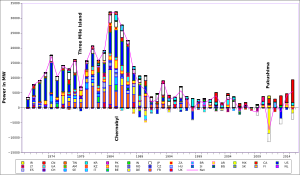This article needs to be updated. The reason given is: effect of Russia sanctions. (May 2022) |

Since about 2001 the term nuclear renaissance has been used to refer to a possible nuclear power industry revival, driven by rising fossil fuel prices and new concerns about meeting greenhouse gas emission limits.[2]
The term emerged in a context brought about by a worldwide slowdown in the rollout of new nuclear projects. The quantity of nuclear electricity generated worldwide had previously had a marked increase in the period from the late 1970s to the mid-1990s. This was brought about by massive nuclear programs in countries such as the US and France (see graph). With spiralling costs and a decline in the public acceptability of nuclear projects brought about in the aftermath of the Chernobyl nuclear accident in 1986, the speed of the rollout dwindled rapidly, leading to growing questions about the future of the industry.
In the 2000s, the principal vehicle of industry growth was thought to be the project then known as the European Pressurised Reactor (EPR), led jointly by the French and German governments. However, initial implementation of the project was poor, with costly delays and overruns being met with in France, Finland and China.
In 2011, the Fukushima nuclear accident further heightened preexisting doubts about nuclear safety worldwide. Several countries, including Germany, announced a complete withdrawal from nuclear electricity generation. By 2012, the World Nuclear Association reported that nuclear electricity generation was at its lowest level since 1999.[3]
In the 2010s, industry growth was led by advances in China, as seen on the graph below. In 2015, for instance, 10 nuclear reactors were connected to the grid, the highest number recorded since 1990.[4] However, expanding Asian nuclear programs were balanced by retirements of aging plants and nuclear reactor phase-outs with 7 reactors permanently decommissioned that same year.[5] By that time, 67 new nuclear reactors were under construction, including four EPR units.[6]
During the same period, the nuclear industry in Europe and the US was beset with industrial difficulties. In 2015, French nuclear giant Areva, the then-world leader in reactor construction, collapsed, forcing a government-sponsored takeover by utility provider EDF. The restructuring caused further delays in EPR rollout. In 2017, the American producer of the AP1000 reactor Westinghouse Electric Company filed for Chapter 11 bankruptcy protection.[7] Together with delays and cost overruns, the bankruptcy caused cancellation of the two AP1000 reactors under construction at the Virgil C. Summer Nuclear Generating Station.[8]
Despite these concerns, growing apprehension over the energy transition has led in recent years to a reappraisal of the role of nuclear energy as a reliable and carbon-free source of electricity. In particular, the 2022 global energy crisis brought renewed interest in nuclear energy due to low carbon emissions, less need for fuel import and a stable power supply compared to wind and solar. Countries began reversing or delaying nuclear phase-outs and greater attention being given to newer technologies such as Small Modular Reactors alongside increased incentives, such as the European Union listing nuclear energy as green energy.[9]
- ^ "The Database on Nuclear Power Reactors". IAEA.
- ^ "Nuclear Power Today | Nuclear Energy - World Nuclear Association". www.world-nuclear.org.
- ^ Cite error: The named reference
wna13was invoked but never defined (see the help page). - ^ "Ten New Nuclear Power Reactors Connected to Grid in 2015, Highest Number Since 1990". May 19, 2016. Retrieved May 22, 2016.
- ^ Mark Diesendorf (2013). "Book review: Contesting the future of nuclear power" (PDF). Energy Policy.
- ^ "Nuclear Power Reactors in the World" (PDF). Pub.iaea.org. May 9, 2015. Retrieved January 30, 2017.
- ^ Yamazaki, Makiko; Kelly, Tim (March 29, 2017). "Toshiba's Westinghouse files for bankruptcy as charges jump". reuters.com. Retrieved March 29, 2017.
- ^ Plumer, Brad (July 31, 2017). "U.S. Nuclear Comeback Stalls as Two Reactors Are Abandoned". The New York Times. Retrieved August 2, 2017.
- ^ "Small reactors could make nuclear energy big again. How do they work, and are they safe?". World Economic Forum. Retrieved October 22, 2022.
© MMXXIII Rich X Search. We shall prevail. All rights reserved. Rich X Search
